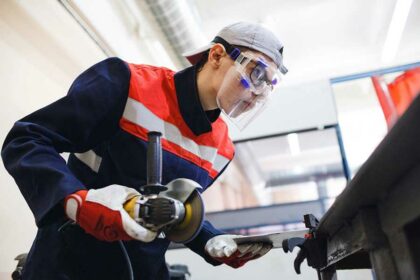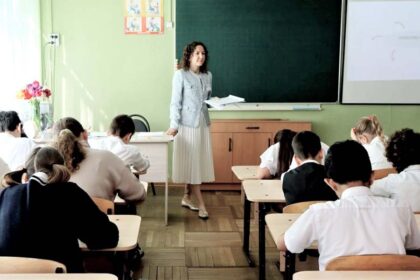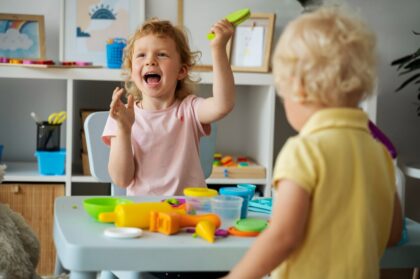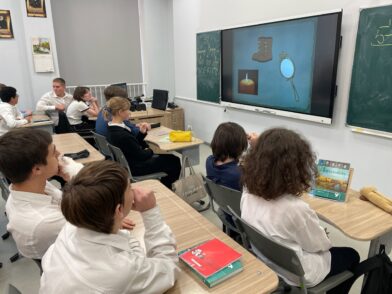В предлагаемом педагогическом опыте рассматривается алгоритм работы с грамматическим явлением “Adjectives Comparison of Adjectives”, суть которого заключается:
– в описании методических приемов, используемых в презентации грамматического материала;
– в разработке системы тренировочных упражнений, развивающих рецептивные грамматические навыки, репродуктивные и продуктивные умения учеников.
Главный критерий успешного обучения иностранному языку – овладение учениками грамматически правильной речью. Сформированность грамматических навыков – это основа развития всех видов речевой деятельности.
Ведущая роль принадлежит системе тренировочных упражнений. Они направлены на формирование языковых знаний и развитие речевых умений.
Грамматические упражнения составлены на основе личного практического опыта.
Зоя Молчанова, учитель I категории.
пос. Новая Надежда,
Волгоградская область
INTRODUCTION
I enjoy teaching English! I try my best to keep up with innovative techniques and modern approaches. I have more than 20 years teaching experience but I should frankly confess that I have gained a lot to enrich myself in the past 4-5 years thanks to OUP (Oxford University Press), a great help for me is “The English Page” in “Uchitelskaya Gazeta” and my lovely magazine “Foreign Languages at School”. That is all an invaluable sourсe of self-education. I’m particularly grateful to the authors of “Happy English” textbooks, we are dealing with. They really help to make learning and teaching English happy.
I’vе decided to participate in the competition. That is a good chance to share practical experience. I hope to be useful to somebody and to give something in return for “stolen” goods from different sources and to do my tiny contribution to education. At present quite a lot of teaching material is available, but to be a good teacher an abundance of resources isn’t enough. I think a teacher should be creative and have wish to work hard.
As for me I try to develop self-potential: my personal qualities and teaching skills. In my opinion the top values of a modern teacher are:
T – tolerant to hardships (can bear an incredible workload, more than 30 hours per week)
E – enthusiastic (though not being paid for months)
A – advanced, able to engage pupils in any situation and achieve progress
C – creative and compitent (thanks to self-education and in service training)
H – headway teacher, hunting constantly for methodological treasure
E – efficient, eager, explorer and exhausted educator
R – reliable and still resistant, realizing successfully teaching principles.
Teaching English I strongly advocate a learner-oriented approach. At my regular lessons the main focus is centred on pupil’s skills development. From the very beginning I try to convince my students that their progress depends much on themselves. There are 3 main parts of a lesson: 3-Ys with you at the centre.
All three parts are equally important and interelated. A teacher and your textbook are decisive factors but not the main. They are your helpers. We are partners. We bouth have our own aims and we have to fulfil them. This way I try to encourage them to co-operate.
First. Then. Next. Finally.
Presently a wide range of teaching material is available and it’s to be clearly indentified and carefully planned. So I first think of what ?-question, i.e. planning, what topics to be covered and what language material to be learning. Then I’m concerned about how? – question? the ways of presenting material, involving students in discovery activities rather than getting information in a passive way from a teacher. Presenting is based on a task-oriented approach. Next the teaching material should be systematically treated. Practising is a very important stage in the chain of development. Students need to be trained properly to achieve good results. I have worked out a set of training exercises for practising any language material to be learned. The final stage in developing students skills is organizing production activity, project work of students. Every lesson is to be step forward in student’s development. Students should feel their progress: today better than yesterday. There’s no sense of fear about failure at my lessons. Students are not afraid to get a bad mark, they become debtors if they are not ready properly for the lesson.
I’ve systematized teaching aims, aids, techniques and activities that I practically implement developing students skills.
5-P. Stages of Students Skills
Development
I’d like to intergrate one grammar theme and support it with appropriate teaching techniques and activities.
As a rule I start working on the theme with a lexical minimum. It is selected according to the usage of adjectives to describe people, animals, weather, school subjects, clothes and other things. Lexical minimum is presented in the form of a camomile. The flower has 6 leaves (6 lexical sets), 60 adjectives. The camomile is done on a cardboard. It is pinned up on the blackboard to present the adjectives and it is used for summarizing purpose on the final lesson.
1. Presenting Adjectives
Jigsaw Learning. Reading. Speaking. Listening. Writing.
Guided reading. Pre-reading information-oriented task.
Do you want to know about the richest man in the world, the oldest tree on earth, the fastest plane and most popular car in the world? Read the text and try to find out some information to complete the table. The class is divided into 4 groups of three, each group is given one of the four texts to read. After silent reading of the text one of the three pupils of each group shares the information from the text using the questions in the table. Other pupils listen and fill in the table.
This kind of activity intergrates all 4 skills. The texts are composed with maximum usage of adjectives.
Text No. 1. The richest man in the world is the Sultan of Brunei. Brunei is one of the smallest but richest countries in the world. Look at the map. It`s in the East Asia. Brunei is rich in oil and gas. The population of the country is very small (230.000). The Sultan is 45 years old. He lives in the biggest palace in the world which has 788 rooms. He has two wives and daughter, 13 years old. He has private planes and air buses.
Do you agree that rich people always happier and more interesting than other people?
The text is illustrated with a picture of Sultan.
Text No. 2. Concorde is the fastest and the most comfortable plane in the world.
It takes 3 hours 25 minutes to fly between London and New York compared with 8 hours in other passenger planes. It is very expensive. There are only 20 Concorde planes. Great Britain has 7 of them. The first flight was on 2 March 1969 in France. Concorde has the most graceful design, it was developed together by France and Britain. How old is Concorde? How many adjectives can you use to describe the plane?
Text No. 3. The oldest tree on Earth grows in California in the USA. It’s called sequois, red-wood tree. It’s very big and tall, it’s more than 30 metres high. It lives more than 3,000 years. It has a very thick bark. Sequois are evergreen trees. They are not afraid of forest fires. The things made of red-wood are very expensive.
Do you know how to learn the age of a tree?
Text No. 4. The Rolls Royce is the most popular limuzine in the world. It’s called after two names: S.Rolls, an English engineer from Manchester the designer of the car, and Henry Royce, a millionaire who gave the money to make the car. It’s a very expensive car because it’s hand-work. It’s very comfortable, elegant and quiet. Englishmen call this car “Queen on wheels” because the English Queen rides only the Rolls Royce. It’s the symbol of Great Britain. The richest and the most popular people: filmstars, kings, businessmen buy the Rolls Royce.
Text No. 5. Would you like to live in the skies?
The tallest building is in the USA in Chicago, 110 floors.
Japanese architects designed a project of the highest building, Aeropolis with 500 floors. Tokyo is the city with the largest population, 15 mln. people. There is not enough land in Japan. They build high buildings. Aeropolis will be 2 kilometres high. It’s 1/3 of the highest Mount Everest. People will live there in the 21st century. The building will be build by robots.
3. Production. Conversation Practice.
1. Pair-work.
– I’ve got a new bicycle.
– Oh, really? What is it like?
– It’s better than my old one? It’s larger, faster and more expensive.
Continue the conversation according to the sample. I’ve got a new car/a new friend/a new jacket/a dog…
2. Boaster competition.
I’m taller than you. My trainers are more popular than yours.
3. Exchange your opinions on your favourite schoolsubjects/animals/famous singer.
4. Discuss the weather today and compare it with weather yesterday.
5. Discuss an ideal choice for the “Best Pupil of the year” in your class (school). Try to convince your partner that your choice is better.
6. At the department store. You want to buy a sweater. Reproduce a talk with a shopassistent.
7. Auction. Class is divided into 3-4 groups. Some boys “design” cars, others “make” furniture, girls are dressmakers or coat desiners. They all present their “goods” and “sell” them by auction. The best seller is the one who can do the most attractive publicity of his/her “design” using as many adjectives as possible. Here’s one of the best advertisments of a group of cardesigners.
If you want to have a pleasant trip in the most comfortable and elegant car trust limuzin “Superlux”. It’s the most popular modern car. It’s smart and very beautiful. It’s quiet. You don’t hear any noise. It’s longer than any other car, toy can sleep there as in your bed. The seats are very comfortable, you seat as in your soft armchaire. It’s never hot and never cold. There’s a special temperature regulator. It’a not boring to have a long trip in this car. There’s a TV-set. You can keep your food in a fridge. The car is expensive but reliable! Save your money and buy “Superlux” (17 adjectives).
8 Adjectives in riddle.
1. Which is the shortest month of the year? (May).
2. In what tree does a bird sit when it is raining? (Wet).
3. Who wears the largest size of boots? (The one who has the largest feet).
4. What is faster than the wind? (thought).
5. It’s sweet and cold, loved by young and old. (ice-cream).
6. I’m not heavy, I’m light. My colour is bright. I can fly to the moon. What am I? (a balloon).
7. High, high in the sky, small and bright you can see it at night. (star).
8. What is the best and cheapest light? (daylight).
9. An old woman has 12 children, some long, some short, some cold, some hot. (year, months).
Writing skills
Compose stories of opposites. Choose two things to compare. Use sa many adjectives as you can.
– 2 cities: Volgograd and…
– 2 countries: Russia and…
– 2 animals, 2 schoolsubjects, your two classmates.
– the weather in summer and autumn.







 Выбор читателей
Выбор читателей






Комментарии